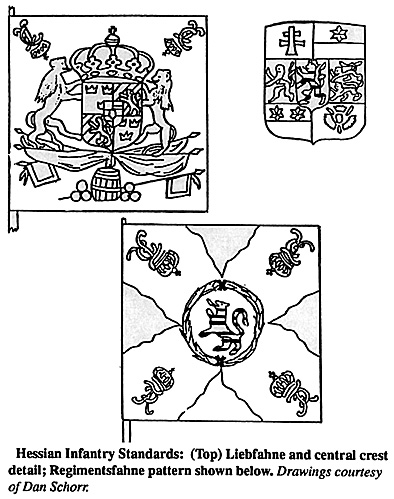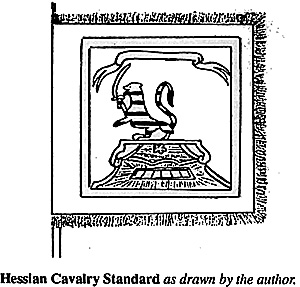 During the War of Austrian Succession, Hesse-Kassel provided
forces for both sides at various times. Initially, Hessian troops were in
English pay in the Netherlands and the Pragmatic Army. Then in 1744
Hesse-Kassel provided an Auxiliary Corps to Kaiser Karl Vll which fought
against the Austrians in Bavaria in 1744 and 1745. With the death of Karl
VII, Hesse-Kassel again switched sides, and the Hessian troops fought in
the Netherlands in English and Dutch pay from 1746 to 1748.
During the War of Austrian Succession, Hesse-Kassel provided
forces for both sides at various times. Initially, Hessian troops were in
English pay in the Netherlands and the Pragmatic Army. Then in 1744
Hesse-Kassel provided an Auxiliary Corps to Kaiser Karl Vll which fought
against the Austrians in Bavaria in 1744 and 1745. With the death of Karl
VII, Hesse-Kassel again switched sides, and the Hessian troops fought in
the Netherlands in English and Dutch pay from 1746 to 1748.
The Triomphes Louis XV contains two examples of Hessian infantry colors - a Liebfahne and a Regimentsfahne. In addition there is a cavalry standard which may be Hessian. Although neither the place of capture nor the unit is identified in the Triomphes, the colors probably belong to infantry regiment Mannsbach which lost them in the defense of Rocoux, during the Battle of Rocoux in October 1746. The cavalry standard, if indeed it is Hessian, was lost at the Battle of Laufeldt in July 1747. Four Hessian cavalry regiments were present at the battle (Prinz Max, Leibregiment, Graffendorf and Isenburg), but there is nothing to indicate to which regiment the standard may have belonged.
The Leibfahne has a white field with the National and Royal coat of arms of Sweden as the central device (the Landgraf was also King of Sweden). The large shield is edged and quartered in gold. The upper left and lower right quarters contain a red lion on a blue and gold striped field. The central escutcheon contains the arms of Hesse-Kassel and is edged in gold.
Clockwise from the upper left there is a red cross on a white field; a black over gold field with a silver star on the black; two gold lions on a red field; white devices on a red field; a black over gold field with two silver stars on the black; a red lion on a gold field. The heart shield has a blue field with a red and whitelsilver striped lion with a gold crown. The lion supporters are gold with red tongues. The crown has a red bag and lining with gold arches and base. The base contains red and blue stones, the orb is gold with a silver cross. Below the coat of arms are trophies.
The upper flags are white and the lower ones are blue. The left hand standard is blue with gold fringe and blue edged gold cords. While the right hand standard is silver with gold fringe and blue edged gold cords. The finials are gold. The cannon balls are silver with black highlights, and the barrel is brown. The monograms (FR) and crowns in the upper corners are in gold.
The Regimentsfahne has a field which is dominated by large, stylized comer flames in blue. The side triangles formed by the flames are white. In the center is a red and white/silver striped lion on a blue field surrounded by a gold/yellow wreath which is secured by red ribbons at the top and bottom. The monograms (FR) and crowns in the corners are in silver.
The cavalry standard has a yellow field. In the center is a gold and white/silver striped lion holding a silver bladed saber with a gold guard. The lion is standing on a burnt gold pedestal whose unshaded areas are white. Above the lion is a white scroll without inscription. The whole is surrounded by a light red frame. The whole is surrounded by a light red frame. The fringe is gold.
 Hessian Cavalry Standard as drawn by the author
Hessian Cavalry Standard as drawn by the author
Since only one Regimentsfahne is illustrated in the Triomphes, it is difficult to draw any positive conclusions on the appearance of the other Regimentsfahne. Nevertheless, a number of possibilities exist:
- 1. All regimentsfahne were the same as that illustrated here or
2. The color of the corner flames was in the regimental facing color, while the side triangles remained white. Infantry regiment Mannsbach had white facings, therefore, blue corner flames to prevent an all white color, or
3. The color of the corner flames was always blue, but the side triangles were in the regimental facing color. This would agree with the white facings of infantry regiment Mannsbach.
Back to Seven Years War Asso. Journal Vol. VII No. 3 Table of Contents
Back to Seven Years War Asso. Journal List of Issues
Back to Master Magazine List
© Copyright 1994 by James E. Purky
This article appears in MagWeb (Magazine Web) on the Internet World Wide Web.
Other articles from military history and related publications are available at http://www.magweb.com